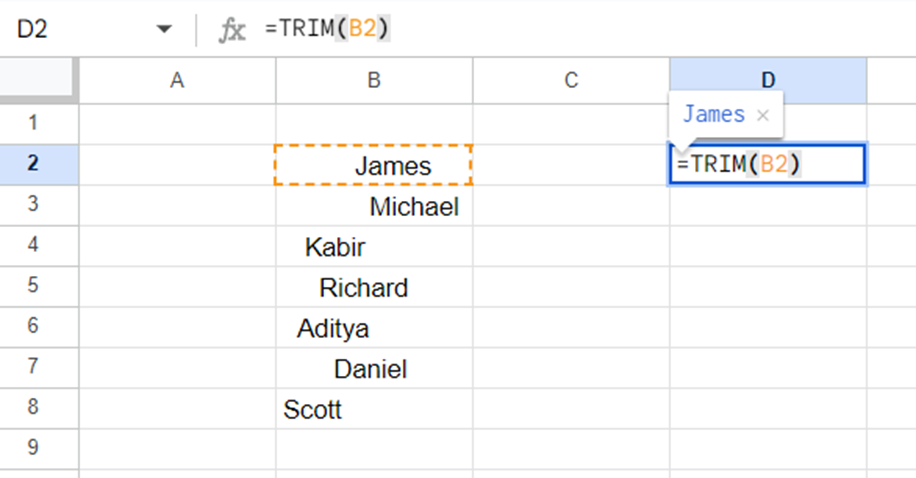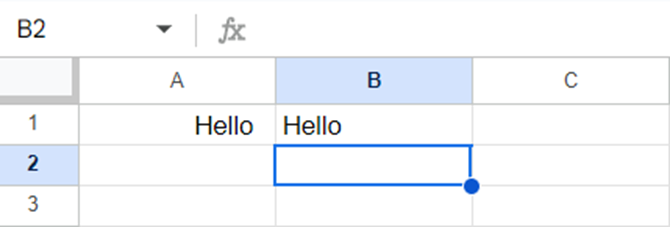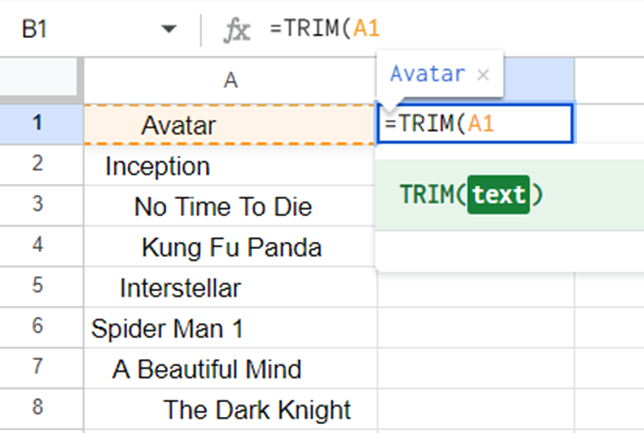Working professionals
Fresh graduates
- Study abroad
- Offline centres
More
27. Columns in Excel
33. Count In Excel
49. Slicers in Excel
54. Solver in Excel
56. Macros In Excel
Trim Function In Excel
The trim function in excel is a simple yet powerful step towards maintaining clean and organized data. Trim snips away any unnecessary spaces lurking around your text entries. It ensures consistency and accuracy in your spreadsheets.
Trim in Excel is the cleaning tool in Excel sheets. It removes unnecessary spaces. These spaces are caused by human typing errors or while copying and pasting the text.
Suppose you have a list of product names, and some entries unnecessarily contain extra spaces at the beginning or end. Applying the trim function in excel will instantly correct this, maintaining consistency across your dataset. This makes your data easier to read and helps Excel work better when sorting or searching.
To use Trim, you type the excel formula trim "=TRIM(text)" into a cell, where "text" is the cell with the messy text you want to clean. Then, Trim removes, leaving your text nice and tidy.
Before,

Source - MS Excel

Source - MS Excel
Learning Trim is simple. Once you understand "=TRIM(text)," you can easily add it to your Excel formulas whenever you need to clean up the text.
How to use TRIM?
● Say you have a cell with " Hello " in it, with extra spaces at the start and end.

Source - MS Excel
○ You apply Trim like this: =TRIM(A1). Hit Enter, and boom! The extra spaces disappear, leaving you with "Hello" – neat.

Source - MS Excel
● Another example: you copy data from a website, and it's messy with spaces all over.
○ Apply Trim to the whole column like this: =TRIM(A1).

Source - MS Excel
○ Drag the Downright blue dot.

Source - MS Excel
○ All your data in column A is clean and ready for action.

Source - MS Excel
Trim works for any text, like names or addresses. It's great for imported data, like CSV files. These files often contain extra spaces that can throw off your calculations or comparisons. With the trim function in excel formula, you can preprocess your imported data, ensuring it's ready for analysis without any surprises.
Trim function in Excel Syntax - syntax and parameters
The trim function in excel follows a simple syntax: =TRIM(text). "text" refers to the cell or range containing the text you want to trim.
Note: The trim function operates only on text strings, disregarding any formatting or numeric values.
The trim function in excel only needs one thing: the text you want to clean up. You can give it a single cell or a group of cells or type in the text directly. It gets rid of extra spaces at the start or end of the text, but it keeps spaces between words.
Examples Illustrating Syntax and Parameters
● Basic Usage
You have " Hello World " in a cell. If you use Trim on it like this: =TRIM(A1), it'll turn into "Hello World" with no extra spaces messing it up.
● Using with Cell References
Let's say you have names with extra spaces in cells A1 to A5. You can use =TRIM(A1:A5) to fix them all at once and make sure they look neat.
● Handling Multiple Spaces
If you have more than one space between words, Trim squishes them down to just one. So, =TRIM("Hello World") would give you "Hello World" by removing the extra spaces between "Hello" and "World".
Advanced techniques of Trim in Excel
How to make Trim even more useful? Learn how to use it with other functions, keep your data clean, and even create your tools. You need to learn the advanced excel formulas to perform advanced techniques of trim in excel.
Learning advanced trim function in excel to remove spaces can be used to make custom functions for your specific needs.
Combining Trim with other functions
The trim function in excel becomes more powerful when combined with other functions such as Concatenate and Substitute. For example, Trim can be used alongside Concatenate to combine text from different cells, which ensures that no leading or trailing spaces are eliminated.
For example, by using Trim with Concatenate, you can merge text from different cells while simultaneously removing any extra spaces. This confirms that there are no extra spaces in your concatenated text, which could lead to formatting problems or mistakes in your data analysis.
Similarly, pairing Trim with Substitute allows you to replace specific characters or strings in a text while also cleaning up any extra spaces that might result from the substitution process.
This combination is useful when dealing with imported data that may contain irregular spacing or formatting inconsistencies.
Using Trim in conjunction with data validation
Data validation is a feature in Excel that allows you to control the type and format of data entered into a cell.
You can make certain your dataset is clean and consistent by adding the trim function in excel formula for your data validation rules. One example of a data validation rule you can create would be to automatically remove leading and trailing spaces from any text that is entered into a range of cells.
This minimizes the possibility of errors and improves more efficient data processing by guaranteeing that users entering data follow a uniform format.
Moreover, incorporating Trim into data validation rules streamlines data entry processes, saving time and improving overall data quality.
Trim function in Excel VBA
● Writing custom functions utilizing Trim in Excel can significantly enhance your data processing capabilities. TRIM in Excel offers a wide range of functionalities. However, in certain cases, you might require customized options to satisfy particular company needs.
● Custom functions created using VBA (Visual Basic for Applications) provide the flexibility to address these unique needs effectively.
● Another advantage of using the trim function in excel vba is the adaptability in handling different types of data. While the Trim function is commonly used to remove spaces from text strings, it can also be applied to other data types, such as numbers or dates, without causing errors. This flexibility improves the overall quality and integrity of data by allowing you to standardize data formats and guarantee consistency across different datasets.
● By incorporating Trim into custom functions, you can make the data consistent by removing unwanted leading and trailing spaces from cell contents. This simple yet powerful operation is particularly useful when dealing with datasets imported from external sources, where irregular spacing is often present.
One common custom function that is used with Trim is data cleansing
For example, you can create a custom function that trims spaces and removes other non-printable characters or formats data in a standardized manner. By doing this, you can save time by preparing data for reporting or additional analysis instead of having to spend it manually cleaning up data.
The Custom trim function in excel to remove spaces also improves the user experience by improving the functionality of Excel spreadsheets. For instance, you could create a custom function that trims spaces from input values entered by users in specific cells, ensuring data consistency and accuracy in real-time.
Tips and Best Practices
Knowing helpful tips and best practices for using excel trim spaces can make managing data easier. From learning quick keyboard shortcuts to avoiding common mistakes, these tips are important for keeping your data neat and correct.
Also, using macros to automate tasks can save you time and effort. By using these strategies in Excel, you'll work faster and keep your data accurate.
Here are some tips to get better at using the trim function in excel:
1. Keyboard Shortcuts for Trim
When it comes to quickly applying Trim in Excel, keyboard shortcuts are the best. Instead of navigating through menus, use the following shortcuts:
● For Windows: Press "Ctrl + Shift + X"
● For Mac: Press "Command + T"
These shortcuts instantly apply the Trim function to the selected cells, saving you time and effort.
2. Avoiding Common Mistakes
Despite its simplicity, using Trim effectively requires attention to detail. Here are some common mistakes to avoid:
● Forgetting to select the entire range: Make sure you've selected all the cells containing the data you want to trim. Missing even one cell can lead to inconsistencies.
● Over-trimming: Be cautious not to overdo it with Trim. Removing necessary spaces within the data can alter its meaning or cause errors in calculations.
● Ignoring non-printable characters: Trim removes leading and trailing spaces, but it does not eliminate non-printable characters such as tabs or line breaks. Consider using additional functions or manual cleaning for such cases.
3. Automating with Macros
To streamline repetitive tasks involving Trim, consider automating the process with macros. Macros allow you to record a series of actions and replay them as needed. Here's how to create a Trim macro:
○ Go to the "Developer" tab and click on "Record Macro."
○ Perform the Trim operation as usual.
○ Stop recording the macro and assign it a shortcut key, or add it to the Quick Access Toolbar for easy access.
○ With macros, you can apply Trim to large datasets or integrate it into complex workflows with just a single click, enhancing efficiency and reducing the possibility of errors.
You will become better at using the Trim function, and your data management tasks will be more accurate and of higher quality if you incorporate these best practices and suggestions into your Excel workflow.
Effectiveness of Trim in Excel real-world scenario
In everyday data tasks, the trim function in excel is valuable. It fixes messy stuff like extra spaces in customer names or product codes in sales reports. This makes sure our data is accurate and tidy.
Being a data analyst, Trim has helped me countless times. Here are some situations that have helped me and will help you by following our guide:
● Suppose, in a sales database, leading spaces in product names can cause errors in analysis. Applying Trim ensures accurate data processing, leading to informed decisions.
● Before, a spreadsheet containing customer emails displayed errors due to trailing spaces. After using excel trim spaces, the emails were clean, reducing bounce rates and improving communication efficiency.
● Using Trim saves time and boosts efficiency. In a payroll system, employee IDs with extra spaces caused delays in salary processing. Implementing Trim reduced processing time by 20%, enhancing productivity.
Time and efficiency gains
Without Trim, the manual removal of spaces is time-consuming. In a large dataset, this process can take hours. However, with Trim, the task is completed within seconds, saving valuable time. Also, Trim reduces the risk of errors associated with manual data cleaning, ensuring accuracy and efficiency in Excel workflows. Overall, using the trim function in excel leads to significant time savings and improved productivity in data management tasks.
In summary
The trim function in excel formula is essential for maintaining clean and consistent data in Excel. By removing unnecessary spaces, it incorporates accuracy in calculations and improves the efficiency of data analysis.
Be mindful of Trim's capabilities and include it in your Excel operations to save time and improve efficiency. Remember that learning Trim is easy and very helpful.
Adding Trim to your toolbox can help you work with Excel more quickly and easily, which will boost your output and data management skills.
If you find learning Excel functions complicated, you can take up an online course from upGrad. Learn the trim function in excel to level up your working capacity.
By learning the functions like TRIM, you can significantly improve your efficiency and productivity at work. Don't miss out on this opportunity to upgrade your skills and excel in your career—sign up now and start boosting your working capacity today!
Frequently Asked Questions
1. How do you use the TRIM function in Excel?
To use the trim function in excel, enter "=TRIM(cell)" into a cell where you want the trimmed text to appear. Replace "cell" with the reference to the cell containing the text you need to trim. To use the trim function in excel, enter "=TRIM(cell)" into a cell where you want the trimmed text to appear. Replace "cell" with the reference to the cell containing the text you need to trim.
2. How do I remove three characters from the left in Excel?
In Excel, you can use the RIGHT function with the LEN function to remove characters from the left. For example, if A1 contains your text, you can use the formula =RIGHT(A1, LEN(A1)-3) to remove the first three characters from the left side of the cell. This formula takes the length of the text in A1 and subtracts 3 to get the desired number of characters to keep from the right side. In Excel, you can use the RIGHT function with the LEN function to remove characters from the left. For example, if A1 contains your text, you can use the formula =RIGHT(A1, LEN(A1)-3) to remove the first three characters from the left side of the cell. This formula takes the length of the text in A1 and subtracts 3 to get the desired number of characters to keep from the right side.
3. What does TRIM mean to do in Excel?
The excel trim spaces function removes extra spaces from text, leaving only single spaces between words and no leading or trailing spaces. It is easy to clean up inconsistent data imported from other sources or entered manually, ensuring consistency in formatting and making it easier to work with the text in your spreadsheet.
4. What is left of TRIM in Excel?
Left TRIM in Excel refers to the function used to remove any leading spaces from a text string. It works by trimming spaces from the left side of a cell's content, leaving the rest of the text unchanged.
5. What is the formula for trim?
The formula for TRIM is "=TRIM(cell_reference)," where "cell_reference" is the reference to the cell containing the text you want to trim. The formula for TRIM is "=TRIM(cell_reference)," where " cell_reference " is the reference to the cell containing the text you want to trim.
6. How do I trim in Excel without a formula?
In Excel, you can trim cells without using a formula by selecting the cells you want to trim, then going to the "Data" tab on the ribbon, and clicking on "Trim" in the "Data Tools" group. It will remove any leading and trailing spaces from the selected cells. In Excel, you can trim cells without using a formula by selecting the cells you want to trim, then going to the "Data" tab on the ribbon, and clicking on " Trim " in the "Data Tools" group. It will remove any leading and trailing spaces from the selected cells.
7. How do I trim only numbers in Excel?
In Excel, you can trim numbers using the `TRIM` function combined with the `TEXT` function. For example, if the number is in cell A1, you can use `=TRIM(TEXT(A1, "0"))` to trim only the numbers present in that cell. In Excel, you can trim numbers using the `TRIM` function combined with the ` TEXT` function. For example, if the number is in cell A1, you can use `=TRIM(TEXT(A1, "0"))` to trim only the numbers present in that cell.
8. Why is the trim formula not working?
The TRIM formula may not work because there are no extra spaces to remove from the text. Double-check that there are leading, trailing, or excessive spaces in the cell content.

Author|15 articles published


upGrad Learner Support
Talk to our experts. We are available 7 days a week, 10 AM to 7 PM
Indian Nationals
Foreign Nationals
Disclaimer
The above statistics depend on various factors and individual results may vary. Past performance is no guarantee of future results.
The student assumes full responsibility for all expenses associated with visas, travel, & related costs. upGrad does not .























-ae8d039bbd2a41318308f8d26b52ac8f.svg)
-35c169da468a4cc481c6a8505a74826d.webp&w=128&q=75)
-7f4b4f34e09d42bfa73b58f4a230cffa.webp&w=128&q=75)



